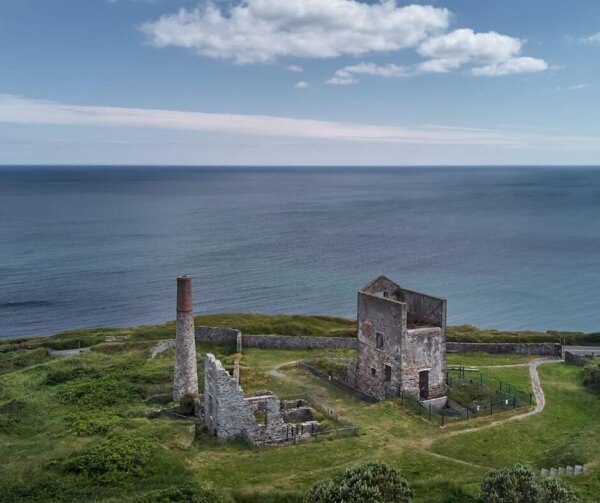If you’re renting a car in Ireland, your intention no doubt is to see some of the beautiful landscape.
 This post contains affiliate links, and I may earn compensation when you click on the links at no additional cost to you.
This post contains affiliate links, and I may earn compensation when you click on the links at no additional cost to you.
And there’s no better way to do that than taking a road trip or two.
While most of the Irish landscape is scenic, there are a few that deserve special mention.
When I say, “road trip,” I don’t mean rushing through the journey simply to mark it off your bucket list.
In fact, I suggest you take your time, not only because some of the roads might be tricky to navigate but because you’ll have a better chance of not missing some cool roadside attractions, including historical markers and other sweet spots along the way.
From the craggy coastline of County Donegal’s Inishowen 100 to the more tranquil Copper Coast in Ireland’s southeast to the various parts of Ireland’s western seaboard, you won’t easily forget these 8 scenic road trips.
All of the journeys mentioned in this blog post are small compared to Ireland’s longest one, the Wild Atlantic Way.
That route is covered in a different post, so definitely check it out if you’re interested in doing your own exploration of the WAW!
Here are the 8 scenic road trips that you should consider taking on your Ireland budget vacation.

- Book the best tours and guides on Tripadvisor, Viator or GetYourGuide
- Get reliable travel insurance with Travel Insurance Master
- Get the best flight tickets with Aviasales
- Rent a comfortable car with Discovercars
- Find the best hotel accommodation on Booking.com
Burren Scenic Drive, County Clare
While The Burren — that distinctive rocky landscape that was formed during the Carboniferous period some 300 million years ago — is normally associated with having a high concentration of ancient heritages sites, the area to the west of it will give you a taste of County Clare’s beautiful coastline.

And along that slice of heaven is where you’ll find the western loop of the Burren Scenic Drive, making its way through the coastal towns and villages of Ballyvaughan, Doolin, Ennistymon, Fanore, Kilfenora, Lahinch, Liscannor, and Lisdoonvarna, as well as Black Head and the Cliffs of Moher.
The eastern part of the drive also begins in Ballyvaughan and includes the Burren National Park encompassing the villages of Corrofin and Carran.
The total distance of the drive is 100 miles/150 km.

In addition to the awe-inspiring karst landscape where flowers and other flora have lived for millions of years, the drive is the perfect way to explore other attractions in the area.
They include the Aillwee Caves, the much-photographed Poulnabrone Dolmen, the Caherconnell Stone Fort, The Burren Perfumery, and the Burren Interpretative Centre in Kilfenora, where you’ll learn more about this fascinating region.

Of course, no visit to the Burren region is complete without visiting the Cliffs of Moher and Doolin, a mecca for Irish music aficionados and others who want to get a real taste of Irish culture.
If an Irish festival experience is on your to-do list, be sure to visit this region in September when you’ll catch the annual Lisdoonvarna Matchmaking Festival.
Copper Coast Drive, County Waterford
When Ireland’s scenic road trips are mentioned by travel bloggers, they often fail to include the Copper Coast Drive in County Waterford.
Perhaps it’s because Ireland’s southeast coast isn’t quite as dramatic as its western seaboard.
But that doesn’t mean it’s less beautiful.
Far from it.

County Waterford has the advantage of being pretty close to Dublin (the drive takes about 1 hour and 55 minutes) and the weather is better than in other parts of the country.
The drive, which is part of the Copper Coast Geopark, is named after the copper mines that were thriving in this part of Ireland during the 19th century.
Far shorter than the Burren Scenic Loop, this 40-kilometer (24 miles) drive is totally worth it as you explore the stunning coastline between the towns of Tramore and Dungarvan along with Waterford’s cool heritage attractions along the way.
Book a B&B in Ireland
Some notable scenic stops along the way include Stradbally Cove, a protected beach that is hidden by a forest, and The Metal Man, a cast-iron statue that overlooks Tramore Bay, protecting fishermen who go into these beautiful — yet sometimes treacherous waters — to catch European seabass and Atlantic pollock.
The statue was one of three pillars erected as maritime beacons after 360 people lost their lives in the HMS Seahorse tragedy of 1816.

Kilfarrasy Beach is another scenic stop along the popular route and is a favorite with both amateur and professional photographers who come to take pictures of its rock formations and islands on either side of the beach.
Other interesting attractions to see on the Copper Coast Drive include the Gaulstown Dolmen, one of the finest examples of a prehistoric portal tomb in Ireland, in addition to the Fenor Bog Walk.

Be sure to get out of your car and follow the boardwalk that goes through 32 acres of wet woodland housing over 200 species of plant, bird, insect, and animal life.
This area is considered a “fen,” which is essentially a peat-based wetland that developed over thousands of years.
It was originally a raised bog where turf was cut but was regenerated in the early 2000s.
It is considered a hotspot of natural biodiversity and a fantastic nature walk to take while you’re exploring the Copper Coast region.
Inishowen 100
Have you been to Donegal?
It is undeniably one of Ireland’s best-kept secrets.

Cut off from the rest of the country for so long (until the 1950s, the county had an expansive rail network), it is finally coming into its own as international tourists discover by rental car this beautiful region.
Getting there by public transportation is of course doable but can take a long time.
One of the country's most beautiful scenic drives is called the Inishowen 100, also known as the Inishowen Peninsula Loop.
You can start this 160-kilometer (100 miles) sign-posted drive anywhere, but the official start of the route is at Bridgend, where you’ll find a large map and other information to acclimate you to the region.
While it can be done in a day, it’s best to take your time on this route.

Some of the notable stops along the way include Grianán of Aileach, a stone fort that sits on a hilltop about 250 meters (820 feet) above sea level.
The origins of the fort, which has been associated with the Tuatha de Danann, an ancient people who inhabited Ireland before the Celts, date back to 1,700 BC.
You can see Lough Foyle and Lough Swilly from the top.

The large fortification known as Fort Dunree is in an equally beautiful location on the precipice of a cliff overlooking Lough Swilly, one of three glacial fjords in Ireland.
It was built by the British to defend the area during the Napoleonic Wars.
There is also an excellent museum adjacent to it that includes a lot of military memorabilia.
Some of the artifacts in the museum’s Rockhill Collection come from Ireland’s defense forces that have served on United Nations, European Union, and NATO-led missions.

The Mamore Gap, about 14 km (8.6 miles) north of Buncrana is another popular stop on the Inishowen 100 and a region my husband and I visited earlier this summer, with James O'Donnell and his canine companions Iggy and Frida as our guides.
Expect to see several holy statues at the summit, where masses are said each year to commemorate a sad chapter in Irish history when the Penal Laws were enacted to discourage Catholics from practicing their religion in public.
Locals often had to resort to attending mass in windswept areas like this to avoid prosecution.
Panoramic views of the Atlantic Ocean and the beautiful Donegal hills can be savored from this viewpoint.

Malin Head, Ireland’s most northerly point, is also on the Inishowen 100 route.
From the official Malin Head Viewing Point, you can see the enormous “Eire 80” sign on the ground, a relic from World War II, and on a good day, you can even see the hills of Scotland.
Explore Ireland Deals and Discounts – TourRadar Explorer Tours
Lough Conn Drive, County Mayo
This 102-kilometer (63 miles) looped drive in County Mayo is a must-see if you want to experience the rugged beauty in this part of Ireland.
In fact, it’s the perfect off-the-beaten-path attraction to explore if you’re looking to add a spectacular road trip to your Ireland budget vacation.
The route begins in Ballina, which is a 20-minute drive from Lough Conn, Ireland’s seventh-largest lake.

As you drive around the lake, you can’t miss Nephin (pronounced “Nayfin”), the second-highest peak in the West of Ireland.
In fact, if you want to see the lake from above, a hike to the summit of Nephin (locally known as Nephin Mór) is recommended.
The mountain stands at 806 meters (2,644 feet) and takes about four hours to climb.
You can get to it by traveling south from Crossmolina on the R315 and taking a right, then driving for 4 kilometers (2.48 miles) before getting to the Nephin car park.
Be sure you are properly prepared before you climb any mountain in Ireland, including this one.
You’ll find more information on the Crossmolina tourist website, or if you want to stop at the Crossmolina tourist office, the friendly staff will also provide you with assistance.

Pontoon is a beautiful little lakeside village on the Lough Conn Drive that is sandwiched between Lough Conn and Lough Cullin, and is a popular destination for anglers.
There are several forest trails and lakeshore walks around Pontoon that you can take as well.
Louth Heritage Trail, County Louth
Louth might be Ireland’s smallest county but that doesn’t mean it lacks the beauty and charm that is common across the Emerald Isle.
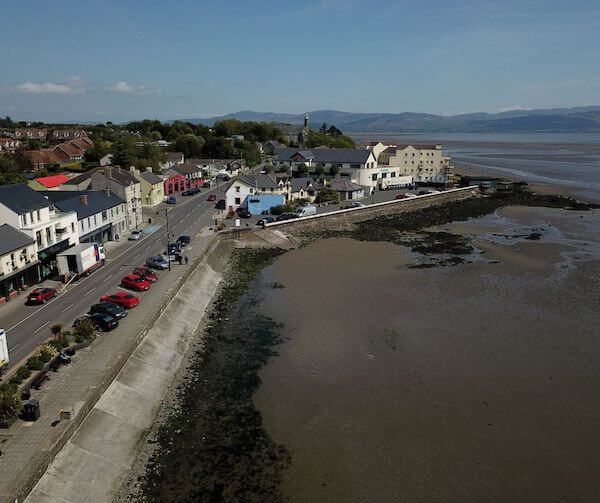
One way to explore the “wee county” is to take the Louth Heritage Trail, a self-drive that will bring you along the county’s short — yet beautiful — coastline, as well as its scenic countryside.
There are three routes that you can take. They include the following:
- Route 1, which includes Drogheda and Louth’s coastal villages (Beaulieu, Baltray, Termonfeckin, Clogherhead, Annagassan, Castlebellingham, Dromiskin, and Blackrock)
- Route 2, which includes Dundalk, Carlingford, and the Cooley Peninsula and
- Route 3, which includes Ardee, mid-Louth, and several Boyne Valley landmarks.
Some of the treasures to be discovered in Drogheda include the town’s Millmount Museum, which houses a unique collection of 19th-century guild and trade banners, an authentic 18th-century Irish folk kitchen, and other fascinating pieces of memorabilia.
The museum is housed in Drogheda’s impressive Norman tower, which is part of the town’s Millmount Cultural Quarter, where you’ll find craft shops, art galleries, a café, and more.

Other attractions along Louth’s coast include Beaulieu House and Gardens, a 17th-century home that overlooks the banks of the Boyne River.
Guided tours of the house and walled garden are available, although you can take a self-guided tour of the garden for free.
The building, one of the few Dutch-inspired houses in Ireland, has changed little since its original construction, making this a must-see attraction on your Louth Heritage Trail drive.

If you choose to take the second route, you’ll find yourself in the charming town of Carlingford, one of Ireland’s best-preserved medieval villages.
Wander down its narrow medieval streets, stop at the 15th-century Thosel building, which once served as a toll gate for traders visiting the town, and explore King John’s Castle, The Mint, and Taafe’s Castle, all a reminder of this town’s ancient past.
Before you leave, be sure to take the Carlingford Lough Ferry, which takes passengers and their cars from Greenore, a 20-minute drive from Carlingford across the lough to Greencastle in County Down, an hour from Belfast.
Ring of Beara, County Cork
Like the Lough Conn Drive in County Mayo, this drive located in West Cork’s Beara Peninsula is another piece of wild, beautiful countryside in Ireland that you should include in your Ireland road trip itinerary.
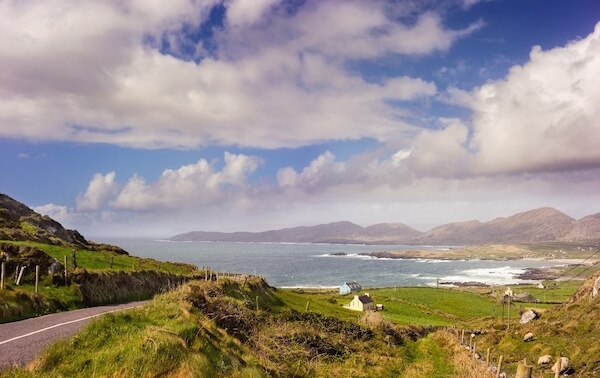
The route runs through Counties Cork and Kerry but is less well-known than the neighboring Ring of Kerry.
The route, about 130 kilometers (80 miles), is doable in a day and can be done in about 4 hours.
You can begin the Ring of Beara drive in either Glengarriff in County Cork or in Kenmare, County Kerry.

Perhaps one of the most stunning parts of the Ring of Beara is the Healy Pass, which winds its way through some of County Cork’s most isolated countryside and up and across the Caha Mountains, listed as a Special Area of Conservation.
The road itself was constructed in 1847 at the height of Ireland’s Great Famine as a way to provide work for the poor, starving local people. It was named after Timothy Healy, the first governor-general of the Irish Free State.
If you’re looking for Atlantic views off the Ring of Beara, you’ll find them in Eyeries and in Allihies.
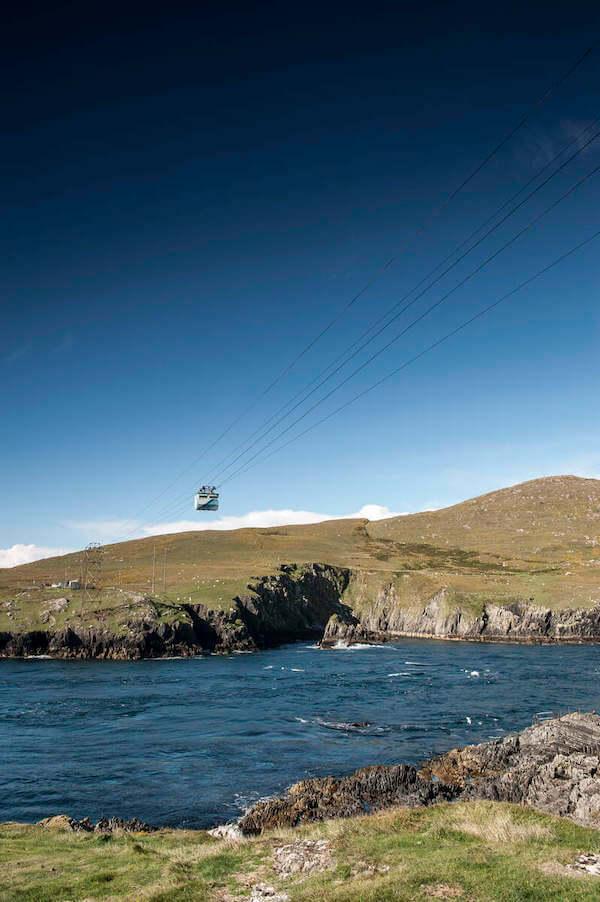
Along the drive, you’ll also see access to the Dursey Island cable car, which brings passengers from the mainland to Dursey Island.
The cable service is currently closed but is expected to re-open in November, with extended services.
Ring of Kerry, County Kerry
The Ring of Kerry is undoubtedly Ireland’s most illustrious attraction, and it’s easy to see why.
Located on County Kerry’s Iveragh Peninsula, it includes everything from dramatic cliffs, beautiful beaches, and of course the beautiful and infamous Lakes of Killarney.

Start the 179-km (111 miles) journey in Killarney, Kerry’s most popular tourist town.
Give yourself at least 3.5 hours or more for this road trip.
When you start your journey in Killarney, be sure to drive in a clockwise fashion as you don’t want to be stuck behind the many tour buses that go the other way!
The most scenic part of the Ring — if the coastal section is of most interest to you — is the Skellig Ring Road, an 18-km (11 miles) stretch where you will see Skellig Island, a UNESCO World Heritage Site that houses a centuries-old monastery.
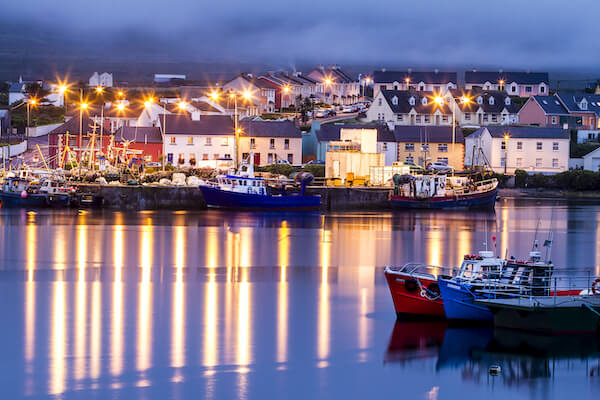
The short detour off the main Ring route will also bring you through the pretty coastal villages of Portmagee and Ballinskellig.
Other must-sees along the Ring of Kerry drive include The Gap of Dunloe, Moll’s Gap, Ladies View, and Derrynane Beach.
Be sure to visit Muckross House Gardens and Traditional Farms, which is part of the Ring and is located in Killarney National Park.
Other popular drives in County Kerry include the Slea Head Drive and you find more information on that in this blog post.
Sky Road, Clifden, County Galway
If you find yourself in Galway City, you should make time for a road trip to Connemara.
If you’re short on time, the 25-kilometer (15 miles) Sky Road Loop shouldn’t take too long – about 2.5 hours at most, allowing for stops along the way.
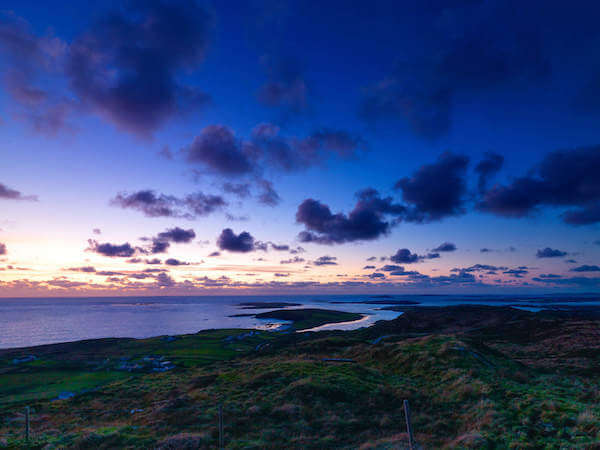
There are two routes that you can take.
A few miles into the drive from Clifden (the capital town of the region and the starting point), you will have the option of taking the Upper Sky or the Lower Sky Road.
My suggestion is to take the Upper Sky Road as the views are more outstanding.
Clifden Castle is one of the attractions you’ll discover at the beginning of the drive.

It was once the home of John D’Arcy, Clifden’s founder.
Constructed in the Gothic Revival style, the castle ruin is now covered in ivy, but in its heyday, it was part of a large 17,000-acre estate.
Much of the land was split up when the family fell on hard times during the famine.
The Sky Road Drive Viewpoint, a designated stop along the Wild Atlantic Way route, is another popular stop along the route.
The views stretching across the Atlantic to the offshore islands, Inishturk and Turbot Island, are totally worth the effort.

Don’t miss views, too, from the Old Coastguard Station, now turned into self-catering apartments that cost between €400/$388/£357 and €550/$535/£491 a week during the spring/summer months.
Head to TripAdvisor to read reviews of this accommodation.
The building was similar to other coast guard stations built by the British around the Irish coastline during the 1800s.
When the Civil War broke out in Ireland in 1922, the building was burned to the ground.
Are these 8 scenic road trips part of your Ireland vacation plan? Let me know in the comments below.
Read More: From Dublin to Sligo in 10 Days: Big City Attractions to Coastal Adventures

